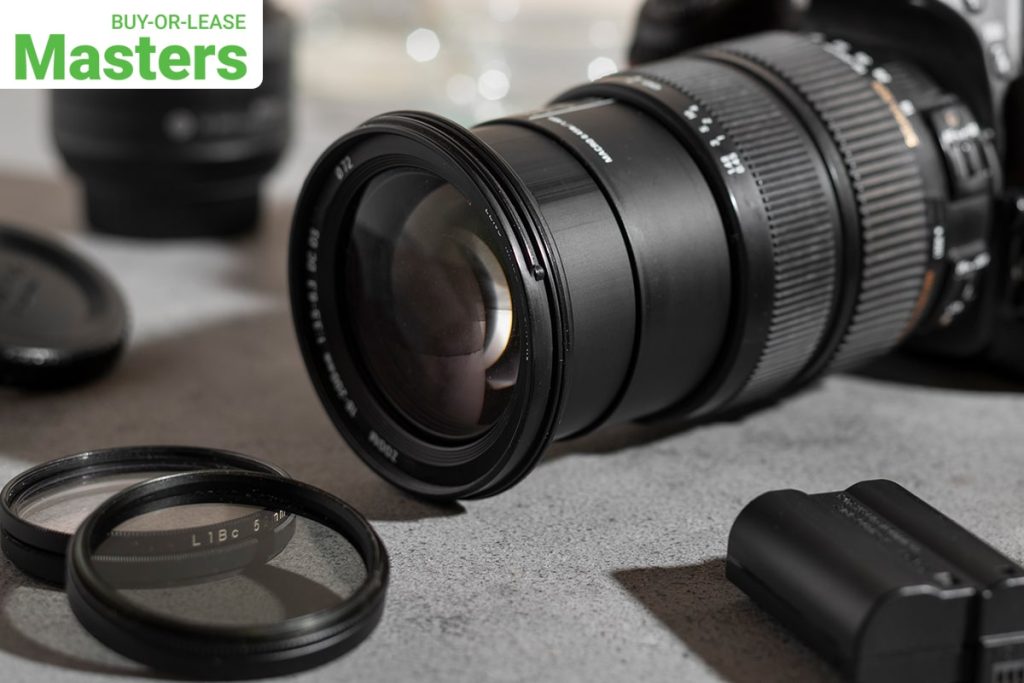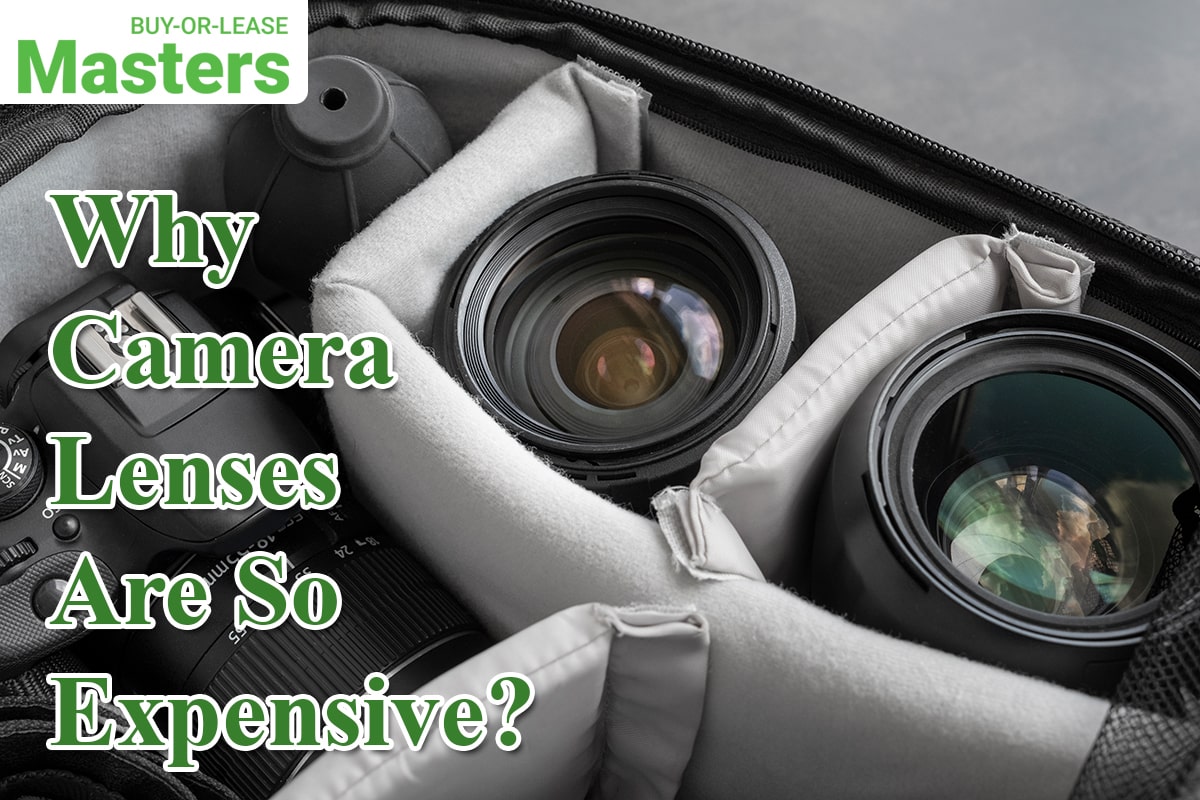For photographers, the lenses they use are their most important tool. But when it comes to buying them, there’s always a question about why camera lenses are so expensive?. After all, what makes some camera lenses so costly compared to others? Mastersbuyorlease will explore this topic and look at the reasons behind these high prices in this article.
From understanding aperture and focal length to discussing technologies like Vibration Reduction or Ultra-Low Dispersion elements used by top end lenses, Mastersbuyorlease will uncover the mystery of why camera lenses cost so much and how you might save money on your next purchase.
What determines the quality of a camera lens?

When it comes to camera lenses, quality and price usually go hand in hand. But what exactly determines the quality of a lens? There are several factors that contribute to the high prices of camera lenses.
1.Aperture
The first factor is aperture. The wider the maximum aperture, the more light that can enter the lens and reach the camera’s sensor. This means that lenses with wider apertures can perform better in low light conditions, produce a shallower depth of field and create more pleasing background blur. However, creating large aperture lenses requires advanced optical design and manufacturing techniques, which drives up the cost.
2.Focal Length
The second factor is focal length. The focal length of a lens affects its angle of view, magnification level, and depth of field. A longer focal length will produce a narrower angle of view and more magnification, while a shorter focal length will have a wider angle of view and less magnification. Advanced optical design is required to create lenses with varying focal lengths, which can contribute to the high cost.
3.Quality of Glass
The third factor is the quality of glass used in the lens. The type of glass used can greatly impact the overall image quality and performance of a lens. Higher quality lenses use special types of glass, such as Ultra-Low Dispersion or Fluorite, which reduce color fringing and improve sharpness. These materials are expensive to produce, making them one reason why some camera lenses command high prices.
4.Specialized Technologies
Lastly, specialized technologies such as Vibration Reduction or Image Stabilization can drive up the cost of camera lenses. These features allow for better handheld shooting in low light situations and require advanced mechanisms to be built into the lens, resulting in higher prices.
The importance of lens elements like ultra-low dispersion, aspheric and Vibration Reduction (VR) technology

Camera lenses are made up of multiple elements, each with a specific purpose. Some common types of lens elements include aspherical, ultra-low dispersion, and Vibration Reduction (VR) technology.
1.Aspherical Elements
Aspherical elements help to reduce image distortion and aberrations in the lens. These specially shaped glass pieces can improve overall sharpness and correct irregularities in the image.
2.Ultra-Low Dispersion Elements
Ultra-low dispersion elements, also known as ED or UD elements, are used to reduce chromatic aberrations in a lens. These types of elements can greatly improve the overall color and sharpness of an image by reducing color fringing.
3.Vibration Reduction (VR) Technology
Vibration Reduction (VR) technology is a feature that helps to reduce the effects of camera shake in handheld shooting. This technology works by using internal gyroscopes and motors to stabilize the lens, allowing for sharper images in low light situations or when using slower shutter speeds. However, this technology can greatly increase the cost of a lens due to the advanced mechanisms required.
Aperture and focal length – why bigger is better (and more expensive)
The aperture and focal length of a lens are two crucial factors that contribute to the overall image quality and performance. In general, larger apertures allow for more light to enter the lens, resulting in better low light performance and shallower depth of field. This means that lenses with wider maximum apertures, such as f/1.4 or f/2.8, are often more expensive due to the complex optical design and manufacturing processes required.
Similarly, longer focal lengths also require advanced optical designs, resulting in higher costs. Telephoto lenses with longer focal lengths tend to be more expensive than standard or wide-angle lenses.
Why lenses with special features are more costly?
As mentioned before, specialized technologies such as Vibration Reduction or Ultra-Low Dispersion elements can greatly impact the cost of a camera lens. These features require advanced mechanisms and materials to be built into the lens, resulting in higher prices. Additionally, lenses with these special features often perform better and produce higher quality images, making them more desirable and driving up their cost.
Shopping for great lenses without breaking the bank – tips and tricks
Now that we have explored the reasons behind the high prices of camera lenses, here are some tips and tricks for finding great lenses without breaking the bank:
- Consider buying used or refurbished lenses: This can significantly lower the cost of a lens without sacrificing quality.
- Look for older models: Newer versions of lenses often come with updated features, but older versions can still produce excellent results at a lower cost.
- Invest in prime lenses: Prime lenses with fixed focal lengths tend to be less expensive than zoom lenses with variable focal lengths.
- Do your research: Before making a purchase, read reviews and compare prices from different retailers to find the best deal.
By understanding the factors that contribute to the high prices of camera lenses and utilizing these tips, you can find great lenses without breaking the bank.
Note: This is not the end, as there are always new advancements and technologies being developed in the world of camera lenses. Keep an eye out for future releases and don’t be afraid to invest in a high-quality lens that will greatly enhance your photography skills.
How to take care of your lenses and keep them in tip-top shape?
As expensive as camera lenses may be, it is important to take care of them properly in order to maintain their performance and longevity. Here are some tips for keeping your lenses in tip-top shape:
Keep them clean: Use a lens cleaning solution and microfiber cloth to gently clean the front and rear elements of your lens.
Protect them: Invest in a good quality lens cap or protective filter to keep dirt, dust, and scratches away from the lens.
Store them properly: Keep your lenses in a dry, cool place when not in use, preferably in a padded camera bag or case.
Avoid extreme temperatures: Exposure to extreme heat or cold can damage the internal mechanisms of a lens.
What Makes High-End Camera Gear So Expensive?
1. Production Costs and Quality of Components
The production costs of high-end camera gear, including lenses, can be significantly higher due to the use of top-quality materials and advanced manufacturing processes. This results in a more durable and reliable product, but also drives up the price.
2. Quality Thresholds and Testing
Companies that produce high-end camera gear often have rigorous quality control processes in place, which includes testing each component individually to ensure the highest level of performance. This can also contribute to the overall cost of the product.
3. Optical Design and Innovation
In order to stay ahead in the highly competitive camera market, companies are constantly investing in research and development to improve their optical designs and incorporate new technologies. These advancements often come at a higher cost, but also result in better performance and image quality for the consumer.
4. Lens Elements and Coating
High-end lenses often use a larger number of lens elements, which are made from specialized materials and coated with anti-reflective coatings to improve image quality. These components can be expensive to produce, but greatly enhance the overall performance of the lens.
5. Image Quality (Sharpness and Contrast)
High-end lenses are designed and manufactured with the goal of achieving the highest level of image quality possible. This includes sharpness, contrast, and color accuracy. Achieving these high standards can require advanced optical designs and precise manufacturing processes, which ultimately contributes to the higher cost.
6. Image Quality (Colors)
High-end lenses often produce more accurate and vibrant colors in images. This is achieved through the use of specialized glass elements and coatings that help to minimize color fringing and other optical imperfections. The added cost of these components contributes to the overall price of the lens.
7. Format and Compatibility
Lenses designed for larger sensor sizes, such as full-frame cameras, tend to be more expensive due to the increased amount of materials and design complexity required. Additionally, lenses with compatibility across multiple camera systems may also come at a higher price point.
8. Maximum / Constant Aperture
Lenses with wider maximum apertures or constant apertures throughout the zoom range are often more expensive than lenses with narrower maximum apertures or variable apertures. This is because larger aperture sizes require more complex and precise optical designs, resulting in higher costs.
9. Bokeh Quality
Bokeh refers to the aesthetic quality of the out-of-focus areas in a photograph. High-end lenses often produce smoother and more pleasing bokeh, which is achieved through specialized optical designs and higher quality materials. This can also contribute to the overall cost of the lens.
10. Autofocus Speed and Accuracy
High-end lenses often come with advanced autofocus systems that are fast and accurate, resulting in better performance for the photographer. These features require more complex technology and manufacturing processes, which can add to the cost of the lens.
11. Fixed Lens Size
Many high-end lenses have a fixed focal length, also known as prime lenses. These lenses offer superior image quality and performance, but are often more expensive due to the specialized optical designs and limited versatility compared to zoom lenses.
12. Construction and Durability
High-end lenses are often built with more durable materials and have weather-sealing to protect against dust, moisture, and other environmental factors. This adds to the overall cost of the lens, but also ensures a longer lifespan and better performance in various shooting conditions.
13. Weather Sealing
Lenses with weather sealing are designed to withstand harsh environmental conditions, making them more suitable for outdoor and adventure photography. This feature adds to the cost of the lens, but also offers added protection and durability.
14. Weight and Size
High-end lenses are often larger and heavier due to the use of more advanced components, such as larger lens elements and complex optical designs. This can also contribute to the higher cost of the lens.
Conclusion
Camera lenses may look simple to use, but each design involves complex technology that makes them more expensive to produce and more reliable for photographers. Understanding why some lenses cost so much is important in order to make a well-informed purchasing decision. With the help of informative blogs such as this one, you can have the tools necessary to make smarter decisions when selecting camera lenses for your photography needs.
Knowing the features available in different types of lenses can make it easy to apply the right features to the right type of job and save money in the long run. As photography continues to evolve, we at Mastersbyorlease will keep our readers informed on what’s new and how they can use it. Have any additional questions? Leave a comment below.


Leave a Reply